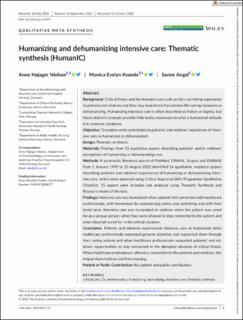| dc.contributor.author | Nielsen, Anne Højager | |
| dc.contributor.author | Kvande, Monica Evelyn | |
| dc.contributor.author | Angel, Sanne | |
| dc.date.accessioned | 2022-12-23T13:21:03Z | |
| dc.date.available | 2022-12-23T13:21:03Z | |
| dc.date.created | 2022-11-08T18:17:56Z | |
| dc.date.issued | 2022 | |
| dc.identifier.citation | Journal of Advanced Nursing. 2022, . | en_US |
| dc.identifier.issn | 0309-2402 | |
| dc.identifier.uri | https://hdl.handle.net/11250/3039423 | |
| dc.description.abstract | Background: Critical illness and the intensive care unit can be a terrifying experience
to patients and relatives and they may experience the extreme life-saving
measures as
dehumanizing. Humanizing intensive care is often described as holism or dignity, but
these abstract concepts provide little bodily resonance to what a humanized attitude
is in concrete situations.
Objective: To explore what contributes to patients' and relatives' experience of intensive
care as humanized or dehumanized.
Design: Thematic synthesis.
Materials: Findings from 15 qualitative papers describing patients' and/or relatives'
perceptions of humanizing or dehumanizing care.
Methods: A systematic literature search of PubMed, CINAHL, Scopus and EMBASE
from 1 January 1999 to 20 August 2022 identified 16 qualitative, empirical papers
describing patients' and relatives' experiences of humanizing or dehumanizing intensive
care, which were assessed using Critical Appraisal Skills Programme Qualitative
Checklist, 15 papers were included and analysed using Thematic Synthesis and
Ricoeur's model of the text.
Findings: Intensive care was humanized when patients felt connected with healthcare
professionals, with themselves by experiencing safety and well-being
and with their
loved ones. Intensive care was humanized to relatives when the patient was cared
for as a unique person, when they were allowed to stay connected to the patient and
when they felt cared for in the critical situation.
Conclusion: Patients and relatives experienced intensive care as humanized when
healthcare professionals expressed genuine attention and supported them through
their caring actions and when healthcare professionals supported patients' and relatives'
opportunities to stay connected in the disrupted situation of critical illness.
When healthcare professionals offered a connection to the patients and relatives, this
helped them hold on and find meaning. | en_US |
| dc.language.iso | eng | en_US |
| dc.rights | Attribution-NonCommercial-NoDerivatives 4.0 Internasjonal | * |
| dc.rights.uri | http://creativecommons.org/licenses/by-nc-nd/4.0/deed.no | * |
| dc.subject | Intensivsykepleie | en_US |
| dc.subject | Sykepleier-pasient-relasjoner | en_US |
| dc.title | Humanizing and dehumanizing intensive care: Thematic synthesis (HumanIC) | en_US |
| dc.title.alternative | Humanizing and dehumanizing intensive care: Thematic synthesis (HumanIC) | en_US |
| dc.type | Peer reviewed | en_US |
| dc.type | Journal article | en_US |
| dc.description.version | publishedVersion | en_US |
| dc.source.pagenumber | 0 | en_US |
| dc.source.journal | Journal of Advanced Nursing | en_US |
| dc.identifier.doi | 10.1111/jan.15477 | |
| dc.identifier.cristin | 2070823 | |
| cristin.ispublished | true | |
| cristin.fulltext | original | |
| cristin.qualitycode | 2 | |

